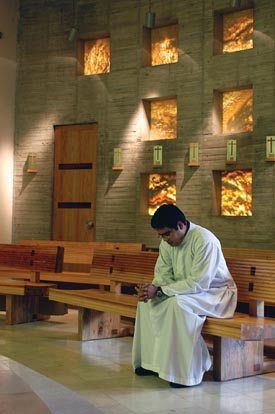When one door closes . . .
Seminary welcomes the undocumented
 What if a young man finds he has a vocation to the priesthood but cannot find a seminary with permission to accept him?
What if a young man finds he has a vocation to the priesthood but cannot find a seminary with permission to accept him?
Such was the case of Héctor Ramírez of the Diocese of Yakima, Washington. “I came from Mexico as a child and did all my studies in the U.S.,” he says. “But when I wanted to enter a seminary, my immigration status made entering one in the U.S. almost impossible.”
For just such promising young men, the Archdiocese of Mexico City founded the Seminario Hispano de Santa Maria de Guadalupe in 2000. The rector, Father Rodrigo Benítez Flores, explains, “The Holy Father in Ecclesia in America insists that in regards to immigrants, it is very important that the dioceses from which they come collaborate with those in which they are received through specific pastoral structures in church practice and legislation. This seminary is one response to the Holy Father’s request.”
Now if an undocumented young man in the United States wishes to pursue a vocation to the priesthood in the diocese he has come to love—and where likely his family and friends live—he has an option. Once he is accepted by the diocese, he can apply to the Seminario Hispano (for some good first information check: cristonosama.net/seminariohispano).
The seminary offers both philosophy and theology, although most candidates take some of those studies in the U.S. as well so they will better understand that pastoral reality. But from Mexico, it is easier to apply for either a student or religious worker visa. Most students will visit their home dioceses on tourist visas while at the seminary.
Besides academics and a complete spiritual and formation system, the seminary offers ESL classes as well as psychological counseling for those who desire it. Liturgies are regularly celebrated in English as well as special courses to prepare the seminarians for their eventual work back in the U.S.
Jonathan Gutíerrez is returning to his home Diocese of Orange, California, after three years at the Seminario Hispano. “As I leave,” he says, “I thank Our Lady of Guadalupe for opening to me this opportunity, and I dedicate myself to serve her and her people as a priest.”
Your turn
- Is there anything you would like to do but you find too many obstacles?
- Would there be a place where you can fulfill your dreams?